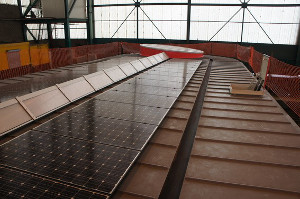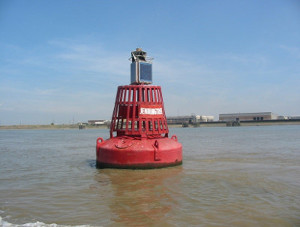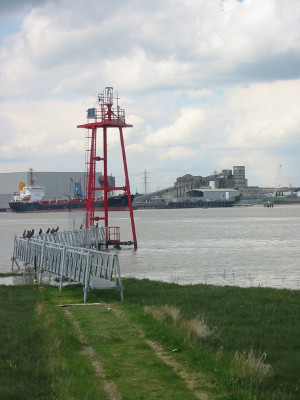Green Technologies on River Thames Structures
 The PLA expects river works licence applications to give consideration to installing green technologies on new river structures or for applications to vary suitable existing structures.
The PLA expects river works licence applications to give consideration to installing green technologies on new river structures or for applications to vary suitable existing structures.
We include the following within our definition of "green technologies":
- Renewable energy - such as wind, solar, heat source and tidal power).
- Shore power - also known as cold-ironing – the provision of shore connections for vessels.
- "Green" technologies - such as energy efficient equipment.
- Resource efficiency – use of recycled and sustainable materials, waste recycling and rainwater harvesting.
All river works licence applications should therefore be accompanied by a report considering green technologies and whether they are feasible. There will be a presumption that variations or new applications for river works licences will include these measures where the report concludes they are feasible.
Why install green technologies?
Working together we can help achieve the Thames Vision goal to encourage uptake of new and green technologies to reduce the port’s environmental impact. For owners / operators of suitable structures there are a number of good reasons for incorporating green technologies, including:
- Reduced local impact – connecting vessels to shore power instead of using on-board auxiliary diesel engines can reduce noise and vibration, reduce air emissions and reduce fuel costs.
- Operational savings – reduced cost of energy from renewables.
- Reduced maintenance - installing energy efficient technologies which have a longer design life (eg LED lights) can reduce maintenance and replacement intervals.
- Security of energy supply - owning renewable energy generating infrastructure will enhance energy security.
- Carbon Footprint - potential for operator’s to reduce their corporate carbon footprint by utilising renewable energy.
- Air quality – demonstration of commitment to reducing local air quality emissions by connecting to shore power during longer stays alongside a structure.
- Corporate Social Responsibility (CSR) - demonstration of CSR credentials by developing renewable energy sources and utilising energy reduction technology.
What green technologies should be considered?
 Suitable technologies for consideration include:
Suitable technologies for consideration include:
-
Renewable Energy
- River source - using the heat mass of the river water via exchange mechanisms for heating or cooling.
- Tidal energy - using tidal flows to generate energy.
- Solar panels – using energy from the sun via photo-voltaic (PV) panels to generate electricity or solar thermal panels to heat water.
- Wind turbines – using turbines to generate electricity by wind power.
- Shore power – allowing vessels to connect to the electrical grid when alongside to avoid running their engines / generators.
- "Green" technologies – such as energy efficient technology, for example using LED lights.
- Resource efficiency – for example, collection of rainwater for non-potable water use (known as rainwater harvesting), use of recycled and sustainable materials and provision of recycling facilities.
What should be considered in the RWL application?
The presumption will be that all River Works Licence applications for variations or new structures will include green technologies unless it can be proved that these are not feasible. The application documents should therefore include a feasibility study which should also consider the potential impacts of the proposals, including, but not limited to:
-
Navigational impacts - The PLA would expect any application to consider the effect of any structures within the river on the safety of navigation. Any such structure should not be in the navigable area, not obstruct safe navigation or manoeuvring and not significantly decrease the depth of the water for passing vessels.
The impact on navigation systems equipment may also need to be considered. - River Regime - Any installation will need to consider the impact it may have on scour and accretion both by operation and construction. Designs must also consider the risk of the fine silt in the Thames, entering and blocking structures, and ongoing maintenance which might be associated with this.
- Environmental - The PLA would expect any application to consider all and any impact that the development might create in the local area both during construction and operation. This is of particular importance where the site is in or near a site with a statutory environmental designation or may affect migratory species.
- Supply/Demand model – demonstrate the power demand on the structure and the percentage of this demand that the proposed technology could supply.
Other consents
 Other consents may be required for the works including:
Other consents may be required for the works including:
- Consent from the District Network Operator (DNO) if you wish to connect renewable energy to the National Grid.
- The Marine Management Organisation (MMO) also licence structures in the Thames below Mean High Water.
- The Environment Agency (EA) issue Environmental Permits (formerly Flood Defence consent) for developments or construction within a specified distance from the flood defences or through them; please consult your local officers or Land Drainage Byelaws for clarificati
What green technologies are the PLA using?
The PLA are successfully utilising green and low energy technologies and shore power on the river, through:
- Shore power at all PLA piers and at our operational support facility at Denton Wharf.
- Solar panels on marker buoys since the 1990s.
- Solar and wind turbine power at lighthouses since the 1990s.
- Low energy LED navigation lights since the 1990s (see Case Study below).
- Solar panels on our two Upper District patrol launches Richmond and Chelsea to supplement power to the onboard electrical systems.
The PLA are also utilising similar technologies on land:
-
 Solar PV panels on the roof at our operational support facility at Denton Wharf to generate renewable electricity.
Solar PV panels on the roof at our operational support facility at Denton Wharf to generate renewable electricity. - Solar thermal (water heating) panels on the roof of our main office in Gravesend to supplement hot water supplies.
- Harvesting of rainwater off the roofs to flush toilets at Denton Wharf.
- Low energy lighting with motion and light level sensors at most of our office sites to ensure lights are only used when needed.
River Thames Renewable Energy Case Studies
Case Study – London River Services Solar Power on Tower Pier

Solar PV panels being fitted to the roof of the Tower Pier extension in 2012.
London River Services (LRS) installed solar PV panels in March 2012 as part of their project to extend Tower Pier. To September 2016, the panels had generated 6,100kWh. LRS found that the economics of installing solar were made viable by being part of a wider project.
Advantages
- Renewable energy.
- The solar panels generate enough energy to power the Pier's lighting.
- Solar power reduces the Pier's carbon footprint.
- Utilises roof space that is not used for any other purpose.
- Silent operation.
Case Study – Port of London Authority Energy Efficient Navigation Lighting

A PLA buoy with LED lamps.
The PLA provide illuminated navigation beacons - 38 floating buoys and 18 fixed buoys which are maintained by the PLA Marine Services team. All buoys have been converted from conventional incandescent filament lamps to light emitting diodes (LEDs). This has led to reduced costs, increased safety and a more environmentally friendly operation. They are powered by batteries which are charged by solar panels.
Advantages
- The LED lamps give a brighter and clearer light, which is easier for mariners to see.
- Low maintenance.
- More reliable - usually lasting for about ten years, whereas conventional lamps need to be replaced twice a year.
- Less waste – lights replaced every ten years rather than every six months reducing waste by up to 95%.
Case Study – Port of London Authority Wind turbines

The PLA have been using wind turbines at lighthouses since the 1990s. These wind turbines, along with solar panels, have replaced mains electric and bottled gas powered lighthouses. The wind turbines have proven to be very reliable, requiring little maintenance, and are essential especially where brighter and more powerful lights are needed and solar panels are not enough on their own.
Advantages
- Clean energy.
- Safer low voltage 12 and 48 volts replacing 230 volts.
- Safer than bottled gas and no longer needing to transport heavy gas bottles.
- Lower maintenance and running costs.
- Less complicated to install than mains power to remote areas.
Page updated August 2017.

